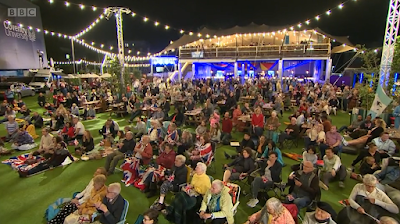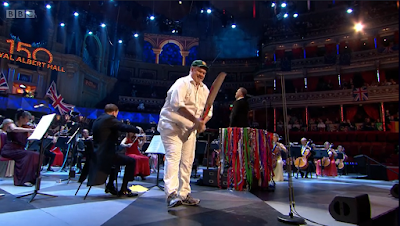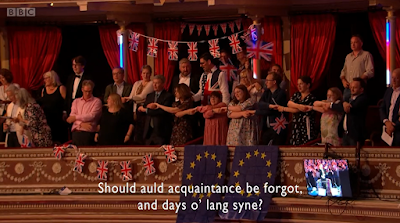Oh dear, a bad day that gets swallowed up in little household chores. Lois takes part in her sect's first worship service on zoom, but the plan is for her to drive over to her friend Mari-Ann's house to take part in the second service over there, with Mari-Ann and June - which is more friendly like.
Lois's friend Mari-Ann (right)
But when it comes to departure time, around 12:15 pm, it turns out that Lois isn't up to driving today so I take her over there to Mari-Ann's house, and pick her up when it's finished.
Plus we have to put in an online grocery order from Sainsbury's Supermarket and a meat and deli order form Waghorne's, the local butcher's shop. Busy busy busy!
Luckily I squeeze in a tiny bit of work on my so-called "presentation". I have foolishly agreed to give a zoom talk on "The Influence of Old Norse on the History of the English Language" to members of Lynda's U3A Middle English group on October 1st.
So far, preparing the talk has been a bit heavy going, to put it mildly!
Today I work on what the Vikings and Norsemen did to the local dialect in Britain's biggest county - Yorkshire, where lots of Danes settled in the 9th and 10th centuries.
Yorkshire England's biggest county
Luckily crazy academic Per Thorson of Bergen University, plus no-nonsense historian and Viking expert John Geipel come to my rescue here.
The game-changing Viking Congress that took place at York
in 1961, where Norwegian Prof Per Thorson of Bergen University was due to give
his legendary talk on "A New Interpretation of Viking", although he couldn't attend
and somebody else had to read out his talk for him. Poor Per !!!!!
Anyway Thorson stuck his neck out in one of his books and claimed that no English county dialect has more Norse loan-words than Yorkshire has. And John Geipel has gone more into specifics:
no-nonsense historian and Viking expert John Geipel
John Geipel says that to the grandparents of people living in Yorkshire today, pigs were "grise", heifers were "quees", and bullocks were "stots". The word for yellow was "gool" and the word for soft was "blowt", large was "stor" and steep was "brandt". All good Norse or Danish words.
What madness !!!
And the city of York's most famous street, the so-called "Whip-ma-whop-ma-gate" can also be explained by reference to the local Norse-influenced dialect. "Gate" was the Norse for "street" of course, as is well-known. But what of the rest of the name? Apparently it means the street where dogs called "whappets" were "whipped" on St Luke's Day. What nonsense!!!!
But poor whappets !!!!!!
13:00 While Lois is over at Mari-Ann's, my sister Gill emails me from Cambridge. After a DNA test, she recently discovered that she and I have a cousin, David, that we didn't know anything about. He's an online journalist and the illegitimate son of our Aunty Joan and a man called Peter. Gill and Lois have been doing a lot of research into Peter's family to try and find out more details of his movements.
Peter was a hotel manager and Joan was his receptionist in a number of the hotels that Peter worked in in various parts of England. It's all a bit embarrassing because Peter was also married and had 2 children with his wife Elizabeth. In 1949, for instance, both Joan and Elizabeth gave birth to a son by Peter, which must have been awkward, to put it mildly.
Until now we had no idea what Peter looked like, but David has now found a picture of him when he was taking the role of best man to his half-brother, also called Peter, at "Other Peter's" wedding in 1949.
What a year that must have been haha!!!!
Flashback to 1949: Peter is standing just behind
the groom, his half-brother Peter's right shoulder
I try to convince Lois that Best Man Peter looks a bit like a devilishly handsome and dangerous-to-know Errol Flynn-style matinee idol or even a Jerry Lee Lewis-style rock'n'roller, the sort of man who perhaps might easily have turned the heads of impressionable young hotel receptionists like Joan.
Lois is not sure, however, so the jury's still out on that one.
mine and Gill's Aunty Joan, pictured in the late 1950's -
was she just the type of hotel receptionist who might have
had her head turned by dashing matinee idol Peter?
The jury's still out on that one, however.
16:00 We sit down with a cup of tea on the couch with the idea of watching yesterday's US Open women's tennis final, which British teenager Emma Raducanu won, but to our disappointment we find out that the recording hasn't worked, and the programme isn't available either on catch-up. I suspect skulduggery by Amazon, who only grudgingly allowed Channel 4 to screen it live yesterday. Boo !!!!
18:00 We have dinner, a CookShop Beef Bourguignon with home-grown vegetables: potatoes, green beans and carrots: yum yum!
for dinner we have CookShop beef bourguignon
with home-grown potatoes, green beans and carrots - yum yum!
20:00 We settle down on the couch and watch the climax of yesterday's Last Night of the Proms concert.
What are my personal highlights? In reverse order:
(4) The crazy crowd on the grass outside Coventry University watching live on screens in the cold - brrrrr !!!!!
the crowd watching live on screens on the grass
outside Coventry University
(3) Inside the warmth of the Albert Hall, zany Latvian accordionist Ksenija Sidorova bringing everybody a touch of sunshine with Piazzolla's Argentinian tango-type music.
Lois and I speculate whether Ksenija has just been on holiday somewhere nice, or perhaps has been to a tanning salon. But which? I think we should be told. This is the type of question that fascinates us and gets us talking - but how shallow we must be, I think sometimes.
(2) the mad Australian tenor Stuart Skelton, dressed as a cricketer for "Rule Britannia" (1740), words by James Thompson, music by Thomas Arne.
(1) the BBC Orchestra's slightly menacing pianist and his amazing ears.
All tremendous fun!!!!
The evening finishes, as always, with Auld Lang Syne:
22:00 We go to bed - zzzzzzzzz!!!!!




























No comments:
Post a Comment